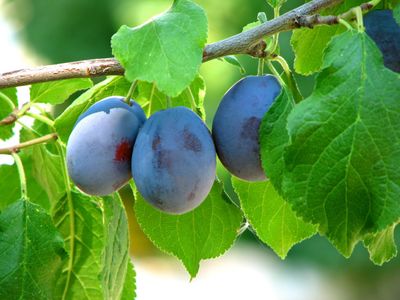What is a Farleigh Damson?
Farleigh damson plums are palm-sized bites of goodness. Their slight acidity and extra hardiness set them apart from standard plums. The trees are small and sturdy, which makes them excellent for windbreaks or hedges and they can be trained to a trellis or espalier. The damson tree is a subspecies of plum. Farleigh damson plums are longer and more oval than regular plums and smaller overall in size. The flesh is firmer and drier and does not break down completely when cooked, unlike plums whose flesh melts into an almost baby food consistency when cooked. Damsons are used more often cooked because the fruit will retain its form. They make excellent preserves or additions to desserts. Farleigh damsons are bluish-black and arrive mid to late season. This damson originated in Kent in the early 1800s. The seedling was possibly a wild sport and grown by Mr. James Crittendon from Farleigh. The tree is also known as Farleigh Prolific due to its heavy cropping habit. It is fairly slow growing and will not attain its maturity until the plant is at least 7 years of age. Depending upon the rootstock, the tree can reach 13 feet (4 m.) or may be smaller. Farleigh damson is a self-fertile tree, but you can get a better crop with a pollinating partner. In addition to its extreme hardiness, the tree is also resistant to many pests and diseases, including silverleaf.
Growing a Farleigh Damson Tree
Like all plums, damsons require full sun. A southern or western site is perfect. Soil should have a neutral pH, be well draining and loam to sandy loam. Keep young trees well-watered and train them early to develop a strong scaffold and sturdy trunk. Little pruning is required on a mature tree, but it can be trimmed at the top to keep fruit at an easy to gather level. Keep weeds and grass away from the root zone. Although damsons are not bothered by many pests, keep an eye on the plant and treat as required. Fertilize trees in early spring before bud break. These are such easy-to-grow trees that the Royal Horticultural Society selected them for an Award of Garden Merit.
